Lessico
Sommacco
Rhus coriaria
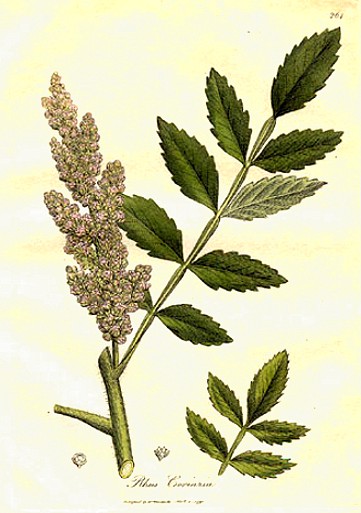
Sommacco deriva dall'arabo summaq. Rhus coriaria: arbusto della famiglia Anacardiacee diffuso nell'Europa mediterranea e in Asia occidentale. Alto 3-4 m, ha foglie imparipennate e fiori bianco-verdastri raccolti in pannocchie terminali. I frutti sono drupe irsute. In numerosi luoghi, e particolarmente in Sicilia, il sommacco viene coltivato per le foglie, dalle quali si estrae un tannino molto pregiato che viene utilizzato nella concia delle pelli e in tintoria.
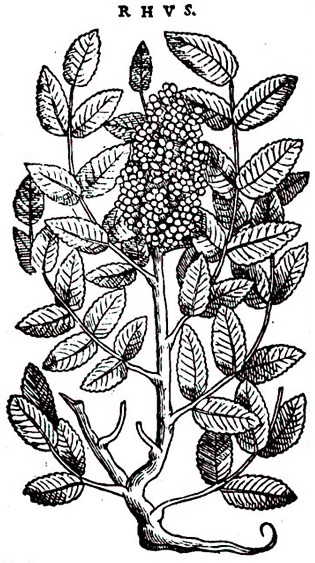
Pierandrea
Mattioli![]()
Commentarii in libros sex Pedacii Dioscoridis Anazarbei
De Materia Medica
Venetiis, apud Valgrisium, 1554
Sumac
Rhus coriaria L.
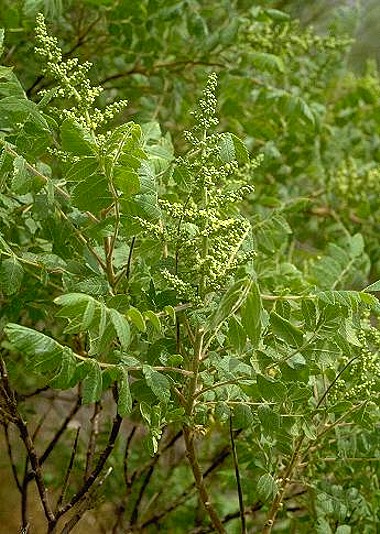
Elm-leafed Sumac, Smooth Sumac, Scarlet Sumac, Upland Sumac, Mountain Sumac, Sicilian Sumac, Sumach, Sumak, Summak, Tanner’s Sumach, French: sumac, German: Sumach, Italian: sommacco, Spanish: zumaque, Arabic: sammak
This spice comes from the berries of a wild bush that grows wild in all Mediterranean areas, especially in Sicily and southern Italy, and parts of the Middle East, notably Iran. It is an essential ingredient in Arabic cooking, being preferred to lemon for sourness and astringency. Many other varieties of sumac occur in temperate regions of the world. In North America Rhus glabra is known for its use in the tanning industry and for its medicinal properties. Also in North America is the related Rhus toxicodendron (poison ivy) which can cause a severe skin reaction when touched.
The berries are dried and crushed to form a coarse purple-red powder. The whole fruit appears in dense clusters. Individual berries are small, round, 10 mm (1/4") in diameter, russet coloured and covered with hairs. Bouquet: Slightly aromatic. Flavour: Sour, fruity and astringent
Preparation and Storage - The berries can be dried, ground and sprinkled into the cooking, or macerated in hot water and mashed to release their juice, the resulting liquid being used as one might use lemon juice. Ground sumac keeps well if kept away from light and air.
Culinary Uses - Sumac is used widely in cookery in Arabia, Turkey and the Levant, and especially in Lebanese cuisine. In these areas it is a major souring agent, used where other regions would employ lemon, tamarind or vinegar. It is rubbed on to kebabs before grilling and may be used in this way with fish or chicken. The juice extracted from sumac is popular in salad dressings and marinades and the powdered form is used in stews and vegetable and chicken casseroles. "The seed of Sumach eaten in sauces with meat, stoppeth all manner of fluxes of the belly..." (Gerard, 1597) A mixture of yoghurt and sumac is often served with kebabs. Zather is a blend of sumac and thyme use to flavour labni, a cream cheese made from yoghurt.
Medicinal Properties - The berries have diuretic properties, and are used in bowel complaints and for reducing fever. In the Middle East, a sour drink is made from them to relieve stomach upsets. It cleanses the alimentary track and is especially useful in healing internal sores, ulcers and wounds on the mucous membranes.
Therapeutic Action - Bark: Astringent, alterative, tonic, vulnerary, antiseptic. Berries: astringent, refrigerant, diuretic, emmenagogue, diaphoretic, cephalic.
Plant Description and Cultivation - A bushy shrub of the Anacardiaceae family, reaching to 3m (10 ft). It has light gray or reddish stems which exude a resin when cut. Young branches are hairy. The leaves are pinnate with up to eleven serrated elliptic leaflets, hairy on the underside. In autumn the leaves turn to a bright red. White flowers are followed by conical clusters of fruit, each enclosed in a reddish brown hairy covering. Easily propagated by seed, sumac grows best in poor soils. In Sicily, where it is widely cultivated and grows wild in the mountains, its quality is found to increase proportionately the higher it is sited.
The staghorn sumac derives its name from the countless tiny hairs covering its branches and resembling the tines of a deer's antlers. Its fruit grow at the terminus of new growth in very large, upright bunches of small, red berries. These small fruit are covered with red hairs and filled with a sour juice rich in malic acid and tannin. Fruit should be gathered soon after turning red, as the longer the remain on the bush the more tasteless they become. Fully ripe staghorn sumac should taste sour.
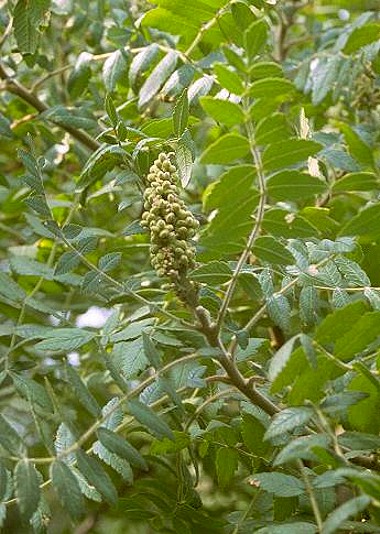
Encyclopedia
of Spices
www.harvestfields.ca
Le
Sumac
ou Somagh - ou Sumach
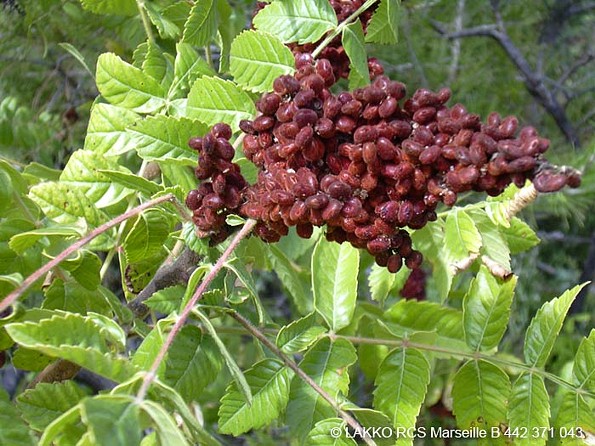
On rencontre très fréquemment le Sumac dans les vallons du Massif des Calanques et dans les garrigues de Provence. C'est un arbuste qui mesure environ 2 à 3 mètres de haut - lorsque le sol est très sec, il est de dimensions plus réduites. Il produit en été des grappes rouges au goût très acidulé. Le sumac est traditionnellement utilisé comme épice ou aromate dans plusieurs pays du proche Orient : Liban, Arménie, Syrie, Iran...
Attention, il existe plusieurs variétés de sumacs, dont certaines sont des poisons violents! (en particulier paraît-il un sumac d'ornement ) donc avant de consommer il faut avoir l'œil exercé....
Nom scientifique du sumac: Rhus coriaria. Le sumac est mûr à la fin de l'été et jusqu'en automne. Autour des petits fruits de la grappe une substance pâteuse rouge violette est sécrétée, c'est là que se concentre l'acidulé du sumac. En randonnée, lorsqu'il fait très chaud, il est bon de mettre quelques grains de sumac dans sa bouche, de sucer cette sécrétion acidulée et désaltérante, puis de recracher les grains. Certaines personnes de culture arménienne préparent elles-mêmes leur poudre de sumac pour saupoudrer les keuftés et la pizza arménienne, ils cueillent les grappes à la bonne saison, les font sécher au four parce que c'est plus rapide qu'au soleil, puis recueillent méticuleusement et patiemment la sécrétion... Il est possible aussi de trouver du sumac tout préparé dans les épiceries orientales, à Marseille Exosud 26 rue Saint Michel 04 96 12 04 26 (quartier de la Plaine), super pour améliorer les grillades, salades, riz etc...
www.lakko.fr